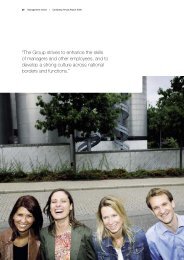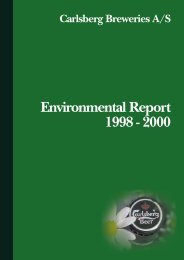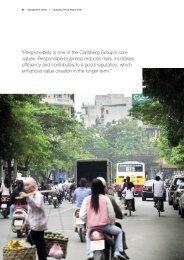Annual Report 2001 - Carlsberg Group
Annual Report 2001 - Carlsberg Group
Annual Report 2001 - Carlsberg Group
Create successful ePaper yourself
Turn your PDF publications into a flip-book with our unique Google optimized e-Paper software.
Financial Review of the <strong>Carlsberg</strong> <strong>Group</strong><br />
73<br />
The company pursues a policy of monitoring<br />
and managing this exposure centrally through financial<br />
transactions, and net debt is an important<br />
element in the company’s hedging of exchange<br />
rate risks. The currency composition of net debt is<br />
based on considerations regarding the composition<br />
of assets and liabilities and the currencies.<br />
The principles governing the management of<br />
exchange risks stipulate that this function is carried<br />
out by the company’s Corporate Treasury department.<br />
The currency exposure in the individual<br />
<strong>Group</strong> companies is eliminated through intra-<br />
<strong>Group</strong> financial transactions and exposure is thus<br />
aggregated and managed centrally.<br />
In <strong>2001</strong>, only minor fluctuations were registered<br />
in the primary currencies involving exchange rate<br />
risks for the company.<br />
Interest rate risks<br />
The most significant interest rate exposure relates<br />
to interest-bearing debt, as the company did not<br />
hold any significant long-term, interest-bearing<br />
assets as at 31 December <strong>2001</strong>.<br />
The company’s loan portfolio consists of listed<br />
bond loans (GBP 200m matures in 2013, GBP<br />
250m matures in 2011 and CHF 100m matures in<br />
2004), bilateral loan agreements and syndicated<br />
credit facilities primarily raised in currencies in<br />
which the company holds assets. The management<br />
of the interest rate exposure involves the use<br />
of interest rate instruments such as interest rate<br />
swaps and options as well as fixed and floating<br />
rate debt.<br />
The long-term debt primarily consists of floating<br />
rate loans (67% in <strong>2001</strong> against 19% in<br />
2000). As at 31 December <strong>2001</strong>, the average<br />
term to maturity of the <strong>Group</strong>’s loans was approximately<br />
1.96 years. The DKK duration is DKK<br />
225m, corresponding to the change in market value<br />
of external debt that a 1% change in interest<br />
rates would cause.<br />
Liquidity risks<br />
To the extent deemed expedient, the company<br />
pursues a policy of managing funding and<br />
placement of liquid funds centrally. Funding takes<br />
place based on the subsidiaries’ investment and<br />
operational liquidity requirements. The subsidiaries’<br />
excess liquidity is equalised internally through<br />
intra-<strong>Group</strong> accounts. Local conditions may mean<br />
that subsidiaries’ borrowing is not handled<br />
centrally.<br />
Credit risks<br />
The company monitors credit risks from central<br />
quarters. Guidelines stipulate that contracts can<br />
only be entered into with financial institutions with<br />
high debtor ratings. Cash at bank and in hand is<br />
deposited with banks with high credit rating and<br />
the company’s trade debtors are distributed in<br />
such a manner that the <strong>Group</strong>’s credit risk is not<br />
considered exceptional.<br />
<strong>Carlsberg</strong> Breweries advances loans to the ontrade,<br />
particularly in the United Kingdom through<br />
<strong>Carlsberg</strong>-Tetley. These loans amounted to approx.<br />
DKK 1.4bn. The loans are subject to continuous<br />
control and supervision, and it is estimated<br />
that provisions made are sufficient to cover any<br />
loss.


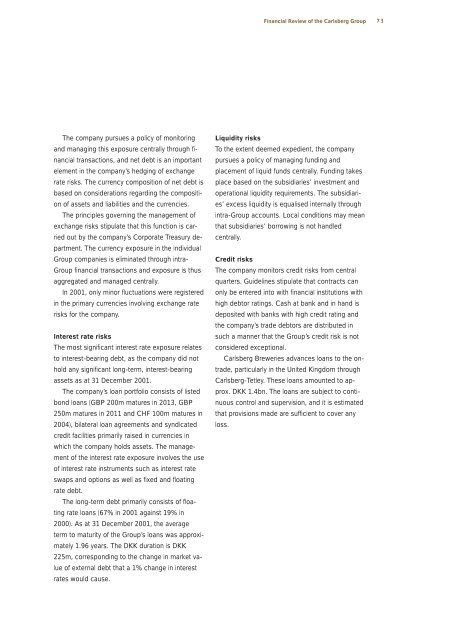
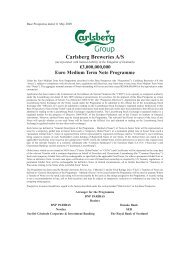
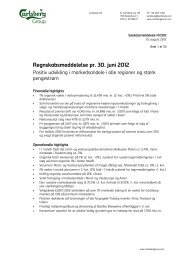

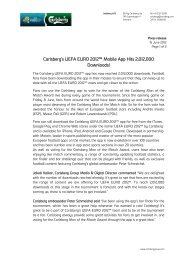
![[Name and Address] - Carlsberg Group](https://img.yumpu.com/49766377/1/184x260/name-and-address-carlsberg-group.jpg?quality=85)

![[Name and Address] - Carlsberg Group](https://img.yumpu.com/49015962/1/184x260/name-and-address-carlsberg-group.jpg?quality=85)
